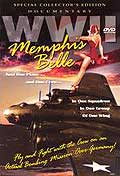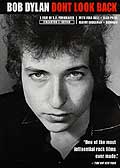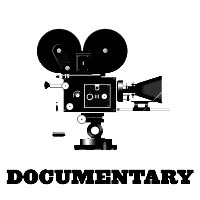 Documentary Films strictly speaking, are non-fictional, "slice of life" factual works
of art - and sometimes known as cinema verite. For
many years, as films became more narrative-based, documentaries branched out
and took many forms since their early beginnings - some of which have been
termed propagandistic or non-objective. Documentary Films strictly speaking, are non-fictional, "slice of life" factual works
of art - and sometimes known as cinema verite. For
many years, as films became more narrative-based, documentaries branched out
and took many forms since their early beginnings - some of which have been
termed propagandistic or non-objective.
Documentary films have comprised a very broad and diverse
category of films. Examples of documentary forms include the following:
|
Types of Documentaries
|
Examples or Types
|
| 'Biographical' films about a living or dead person |
Stephen Hawking - A Brief History of Time (1992)
Robert Crumb - Crumb (1994)
Muhammad Ali - When We Were Kings (1996)
Glenn Gould - Genius Within: The Inner Life of Glenn Gould (2009)
John Lennon - Nowhere Boy (2009)
Ruth Bader Ginsberg - RBG (2018)
Fred "Mister Rogers" - Won't You Be My Neighbor? (2018)
Whitney Houston - Whitney (2018) |
| A well-known historical event |
Night and Fog (1955, Fr.) - The Holocaust
Shoah (1985) - The Holocaust
WACO: A New Revelation (1999)
The Endurance (2000, UK) -
Shackleton's expedition to the Antarctic |
| A concert or rock festival (aka Rockumentary) |
Don't Look Back (1967) - Bob Dylan
Monterey Pop (1968) - Monterey
Gimme Shelter (1970) - Rolling Stones, Altamont
Woodstock (1970)
Ziggy Stardust and the Spiders from Mars (1973) - David Bowie
The Song Remains the Same (1976) - Led Zeppelin
The Last Waltz (1978) - The Band
Stop Making Sense (1984) - Talking Heads
Madonna: Truth or Dare (1991) - Madonna |
| A comedy show |
Richard Pryor or Eddie Murphy shows |
| A live performance |
Buena Vista Social Club (1998) - Cuban musicians
Cirque du Soleil-Journey of Man (2000) |
| A sociological or ethnographic examination following
the lives of individuals over a period of time |
Michael Apted's series of films: 28 Up (1984), 35
Up (1992) and 42 Up (1999)
Steve James' Hoop Dreams (1994) |
| An expose including interviews |
Minamata: The Victims and Their World (1971,
Jp.)
An Inconvenient Truth (2006)
All of Michael Moore's social concerns films:
Roger & Me (1989)
Bowling for Columbine (2002)
Fahrenheit 9/11 (2004)
Sicko (2007)
Where to Invade Next (2015) |
| A sports documentary |
The Endless Summer (1966) - Surfing
Hank Aaron: Chasing the Dream (1995)
To the Limit (1989), Extreme (1999) - Extreme
Sports |
| A compilation film of collected footage from government
sources |
Why We Fight (1943), Frank Capra's WWII
series |
| An examination of a specific subject area |
Historical Surveys (e.g., Ken Burns): The Civil
War, Jazz, Baseball, or World War II |
| Nature- or Science-related themes (Ethnographic,
Natural History or Wildlife Films) |
Nanook of the North (1922)
Walt Disney's The Living Desert (1953),
The Vanishing Prairie (1954)
Microcosmos (1996)
Winged Migration (2001, Fr.)
March of the Penguins (2005) |
| A 'Making of' Film (or "Behind the Scenes") |
Burden of Dreams (1982) - about the making
of Fitzcarraldo (1982)
Hearts of Darkness: A Filmmaker's
Apocalypse (1991) - about the making of Apocalypse Now (1979) |
| A 'Shock' Travelogue |
Mondo Cane (1962) |
| Mockumentary (or Docu-Comedy) |
Zelig (1983)
This is Spinal Tap (1984)
Man Bites Dog (1992, Belg.)
Best in Show (2000)
Borat: Cultural Learnings of America for Make Benefit Glorious Nation
of Kazakhstan (2006) |
| Pseudo-Documentary |
Citizen Kane (1941) - The "newsreel" on Kane
JFK (1991) - Mixing fact and fiction |
The Earliest Documentaries:
Originally, the earliest documentaries in the US and France
were either short newsreels, instructional pictures, records of current events,
or travelogues (termed actualities) without any creative story-telling,
narrative, or staging. The first attempts at film-making, by the Lumiere Brothers
and others, were literal documentaries, e.g., a train entering a station,
factory workers leaving a plant, etc.
The first documentary re-creation, Sigmund Lubin's one-reel The Unwritten Law (1907) (subtitled "A Thrilling Drama Based on
the Thaw-White Tragedy") dramatized the true-life murder -- on June 25,
1906 -- of prominent architect Stanford White by mentally unstable and jealous
millionaire husband Harry Kendall Thaw over the affections of showgirl Evelyn
Nesbit (who appeared as herself). [Alluring chorine Nesbit would become a
brief sensation, and the basis for Richard Fleischer's biopic film The
Girl in the Red Velvet Swing (1955), portrayed by Joan Collins, and E.L.
Doctorow's musical and film Ragtime (1981), portrayed by an Oscar-nominated
Elizabeth McGovern.]
 The first official documentary or non-fiction narrative film was Robert
Flaherty's Nanook of the North (1922), an ethnographic look at the
harsh life of Canadian Inuit Eskimos living in the Arctic, although some of
the film's scenes of obsolete customs were staged. Flaherty, often regarded
as the "Father of the Documentary Film," also made the landmark
film Moana (1926) about Samoan Pacific islanders, although it was less
successful. [The term 'documentary' was first used in a review of Flaherty's
1926 film.] His first sound documentary feature film was Man of Aran (1934),
regarding the rugged Aran islanders/fishermen located west of Ireland's Galway
Bay. Flaherty's fourth (and last) major feature documentary was his most controversial, Louisiana Story (1948), filmed on location in Louisiana's wild bayou
country. The first official documentary or non-fiction narrative film was Robert
Flaherty's Nanook of the North (1922), an ethnographic look at the
harsh life of Canadian Inuit Eskimos living in the Arctic, although some of
the film's scenes of obsolete customs were staged. Flaherty, often regarded
as the "Father of the Documentary Film," also made the landmark
film Moana (1926) about Samoan Pacific islanders, although it was less
successful. [The term 'documentary' was first used in a review of Flaherty's
1926 film.] His first sound documentary feature film was Man of Aran (1934),
regarding the rugged Aran islanders/fishermen located west of Ireland's Galway
Bay. Flaherty's fourth (and last) major feature documentary was his most controversial, Louisiana Story (1948), filmed on location in Louisiana's wild bayou
country.
Merian C. Cooper and Ernest B. Schoedsack, better known for King Kong (1933), directed the landmark documentary Grass: A Nation's Battle for Life (1925), the first documentary epic,
which traced the travels of the Bakhtyari tribe in Persia during their migrational
wanderings to find fresh grazing lands. The filmmakers' next film was the
part-adventure, travel documentary filmed on location in the Siamese (Thailand)
jungle, Chang: A Drama of the Wilderness (1927), about a native tribal
family.
Other European documentary film-makers made a series of so-called
non-fictional city symphonies. Alberto Cavalcanti and Walter Ruttman
directed Berlin - Symphony of a Big City (1927, Ger.) about the German
city in the late 1920s. Similarly, the Soviet Union's (and Dziga Vertov's)
avante-garde, experimental documentary The Man with a Movie Camera (1929, USSR) presented typical daily life within several Soviet cities (Moscow, Kiev, Odessa)
through an exhilarating montage technique. And French director Jean Vigo made On the Subject of Nice (1930). Sergei Eisenstein's October (Oktyabr)/10
Days That Shook the World (1928, USSR) re-enacted in documentary-style,
the days surrounding the Bolshevik Revolution, to commemorate the event's
10th anniversary.
 Depression-Related
Documentaries: Depression-Related
Documentaries:
Pare Lorentz' The Plow that Broke the Plains (1936) documented the deprivations and suffering of the Depression-Era Dust Bowl
farmers. The film was subsidized by one of President Roosevelt's New Deal
organizations. Lorentz' follow-up film was The River (1937), arguing
that the Tennessee Valley Authority (TVA) aided ecological efforts in the
area. Years later, Philippe Mora's Brother Can You Spare a Dime? (1975) compiled newsreel footage, film clips and music from the 1930s to capture
the cultural and historical forces that existed during the decade. Michael
Uys' and Lexy Lovell's Riding the Rails (1997) presented stories of
train-hopping by Depression-era hobos, accompanied by Woody Guthrie's folk
songs.
Documentaries of The War Years:
 Documentaries
during the Great War and during WWII were often propagandistic. Innovative
German film-maker Leni Riefenstahl's pioneering masterwork epic Triumph
of the Will (1935, Germ.) was explicitly propagandistic yet historical in its
spectacular yet horrifying documentation of the Nazi Party Congress rally
in Nuremberg in 1934. It was a revolutionary film combining superb cinematography
and editing of Third Reich propaganda. She also documented the 1936 Berlin
Olympics in the stunning film Olympia (1938, Germ.) - with graceful and beautiful
images of 'Aryan' athletes in competition. To respond to the Nazi propaganda,
Frank Capra was commissioned by the US War Department to direct seven films
in a Why We Fight (1943) series of narrated WWII newsreel-style films.
The first in the series, "Prelude to War," a look at the events
from 1931-1939, won the Academy Award for Best Documentary in 1942. David
Lean's and Noel Coward's In Which We Serve (1942, UK) was not a pure
documentary film, although it boosted the wartime morale of the beleaguered
Britishers. Documentaries
during the Great War and during WWII were often propagandistic. Innovative
German film-maker Leni Riefenstahl's pioneering masterwork epic Triumph
of the Will (1935, Germ.) was explicitly propagandistic yet historical in its
spectacular yet horrifying documentation of the Nazi Party Congress rally
in Nuremberg in 1934. It was a revolutionary film combining superb cinematography
and editing of Third Reich propaganda. She also documented the 1936 Berlin
Olympics in the stunning film Olympia (1938, Germ.) - with graceful and beautiful
images of 'Aryan' athletes in competition. To respond to the Nazi propaganda,
Frank Capra was commissioned by the US War Department to direct seven films
in a Why We Fight (1943) series of narrated WWII newsreel-style films.
The first in the series, "Prelude to War," a look at the events
from 1931-1939, won the Academy Award for Best Documentary in 1942. David
Lean's and Noel Coward's In Which We Serve (1942, UK) was not a pure
documentary film, although it boosted the wartime morale of the beleaguered
Britishers.
 The
Oscar-winning wartime documentary The Memphis Belle (1944), directed
by famed William Wyler (then a Lieutenant Colonel) and released by the War
Department, presented real-life footage of dozens of Allied bombing missions
by the Flying Fortress' B-17 bomber during the war. A Hollywood-style, sentimental
version of this documentary, Memphis Belle (1990), starred Matthew
Modine and Eric Stoltz. The
Oscar-winning wartime documentary The Memphis Belle (1944), directed
by famed William Wyler (then a Lieutenant Colonel) and released by the War
Department, presented real-life footage of dozens of Allied bombing missions
by the Flying Fortress' B-17 bomber during the war. A Hollywood-style, sentimental
version of this documentary, Memphis Belle (1990), starred Matthew
Modine and Eric Stoltz.
Director Alain Resnais' Night and Fog (aka Nuit et Brouillard)
(1955, Fr.) harshly judged the Nazis for inflicting the horrors of the
Holocaust on the world. Marcel Ophuls' four-hour epic The Sorrow and the
Pity (1971) (aka Le Chagrin et La Pitie), mentioned in Woody Allen's Annie
Hall (1977), used an interview technique and archival footage to tell
the story of the Nazi occupation of France and subsequent French collaboration.
Claude Lanzmann's unforgettable, eloquent 570-minute epic Shoah (1985) (Hebrew for 'annihilation') documented the personal experiences of several
death-camp survivors of the Holocaust through interviews.
Rock Concert/Music-Related Documentaries:
Michael Wadleigh's Woodstock - 3 Days of Peace & Music
(1970) provided a definitive look at the three-day counter-cultural rock
concert held in upper-state NY in 1969 - it was the Academy Award winning
documentary film of its year. Other lesser known rock-and-roll and other music-related
documentaries included:
-
 D.
A. Pennebaker's Don't Look Back (1967) - a behind-the-scenes, riveting
look at Bob Dylan's British concert tour in the mid-1960s, and Monterey
Pop (1968) - a record of the international pop festival held in June
1967 D.
A. Pennebaker's Don't Look Back (1967) - a behind-the-scenes, riveting
look at Bob Dylan's British concert tour in the mid-1960s, and Monterey
Pop (1968) - a record of the international pop festival held in June
1967
- the disillusioning, nightmarish and fateful Gimme Shelter
(1970) - filmed by Albert Maysles and David Maysles in 1969 during the
Rolling Stones' US tour at San Francisco's Altamont Speedway, most notorious
for having the Hell's Angels as security and crowd controllers - and concluding
with the stabbing death of black concertgoer Meredith Hunter caught on film as the Stones played Under My Thumb
- Let It Be (1970), the last film starring the Fab
Four; this effort chronicled the Beatles recording their last-produced Apple
studios album - a comeback attempt that actually led to their breakup
- The Song Remains the Same (1976) regarding Led Zeppelin's
Madison Square Garden concert stand in 1973
- Martin Scorsese's The Last Waltz (1978), an historical
documentary about The Band led by lead singer and songwriter Robbie Robertson
- Say Amen, Somebody (1980), about gospel music in a
black church and the life of gospel great Thomas A. Dorsey
- Murray Lerner's 1980 Oscar-winning From Mao to Mozart
- Isaac Stern in China (1979) and Message to Love - The Isle of Wight
Festival (1997)
- Penelope Spheeris' The Decline of Western Civilization
(1981) documented the nihilistic, late 70s punk-rock scene of Los Angeles
with black humor
- Stop Making Sense (1984), director Jonathan Demme's
first feature-length film, a concert film featuring The Talking Heads and their frontman David Byrne
- Madonna: Truth or Dare (1991)
- Canadian director Ron Mann's Twist (1993) - about
the dance craze known as 'the twist' in the mid-60s, popularized by stars
Chubby Checker and Joey Dee
- Wim Wenders' Buena Vista Social Club (1998) followed
guitarist Ry Cooder to Cuba to present the music of various legendary, long-forgotten soneros musicians
|
